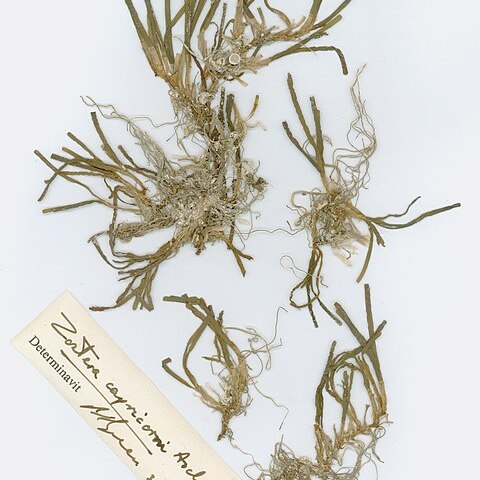Rhizome creeping, with fibre bundles in the innermost layers of the outer cortex, 0.75-2 mm thick, with two groups of roots and a prophyllum at each node; internodes 4-40 mm long. Short branches with 2-6 leaves arising from the axils of the rhizomatic leaves. Leaf sheath 2-10 cm long, as wide as the base of the blade, open, with rather nar-row membranous flaps which do not overlap, but just cover the space between the lateral and intermediate nerves; partially persistent as a scaly mass auriculae obtuse, 1/3-1/2 mm long; ligula very short; nerves 3-5, intermediate and lateral nerves rather close; squamulae intravaginales not seen. Leaf blade 7-50 cm long and 2-5 mm wide, gradually narrowing towards the base, nerves (3-)5; midrib reaching the apex, dilated and sometimes furcate; intermediate nerves usually situated closer to the lateral nerves than to the midrib, joining the midrib just below the apex; lateral nerves marginal or slightly intramarginal, in the apical region distinctly intramarginal, joining the intermediate nerves often far below the apex (at a distance of 3-5 times the width of the leaf) or just as often near the place where the intermediate nerves curve towards the midrib; between the midrib and each intermediate nerve 3-7 accessory bundles; between an intermediate and a lateral nerve 1-4 accessory bundles; between the lateral nerve and the leaf margin in the apical region 1 or 2 accessory bundles; lateral nerves sometimes absent; cross veins perpendicular, at intervals of 0.5-2 mm, also present in the apical region; tip rounded, truncate, sometimes slightly mucronate, slightly denticulate, seldom with a central cleft. Generative shoot lateral, with 1-30 cm long axis, usually with numerous spathes; peduncle of each spathe partly coalescent with the axis from which it springs; connate part in tidal habitats 5-8 mm long, but in still water up to 40 mm long; free part of the peduncle 9-20 cm long, 0.5 mm wide, flat. Prophyllum 15 by 2 mm, sheath-like, amplexicaulous, membranous, transparent, emarginate and bi-auriculate; nerves 3; midrib not reaching the apex; lateral nerves parallel, bending towards and crossing the midrib just below the apex; between each pair of nerves 6-7 accessory bundles; flaps very nar-row; squamulae intravaginales not seen. Spathe: sheath 14-26 mm long and 1.5-2 mm wide, amplexicaulous with 2 obtuse auriculae and a very short ligula; dorsal side of sheath green; flaps overlapping, green except for a c. 0.5 mm wide, membranous, transparent marginal strip; nerves 3, between each pair of nerves 7 accessory bundles; exterior to the lateral nerves 3-4 accessory bundles; blade 30-80 by 1.5 mm, narrowed towards the base; nerves 3-5, near the base only 3; tip as in vegetative leaves. Squamulae intravaginales 2. Spadix linear to spatulate, with a short blunt mucro, with 7-10 female flowers and 7-10 male ones. Stamens: thecae 2-3 by 1-1.5 mm, oblong-ellipsoid, shed immediately after release of the pollen. Retinacula 7-10, obliquely triangular to obliquely ovate, acute but sometimes obtuse, c. 0.6-1.3 mm long, and at the base 1-1.3 mm wide. Gynoecium: ovary cylindrical, 1.5-2 mm long; style 1-1.5 mm long; stigmata 2, 1.5-3 mm long. Fruit ellipsoid, 2 mm long and 1 mm wide, flattened, with a 1 mm long beak; pericarp scarious, brown. Seed ellipsoid, 2 by 1 mm; testa shiny, brown, with c. 16 longitudinal striae; a fine transverse striation also becoming visible at high magnification. Chromosome number: 2n = 24 (New South Wales, Australia; North Island, New Zealand).
More
Similar to Z. muelleri in habit but stouter in all its parts. Lf-lamina 20–50 cm. × 2.5–4 mm.; primary nerves us. > 3, us. at least 1 and often 2 nerves in addition to the median and the 2 marginal ones; interstitial nerves us. > 6, often 8–9, on each side of median; cross veins often ∞ and extending across only 2–3 interstitial nerves, giving a closer and less regular pattern than in Z. muelleri. Erect stems slender and flattened, the "peduncular" internode narrower than the spathe. Spathe-like sheath c. 1.5–2.5 cm. × 3–4 mm. (folded width), its margins squarely truncate at the top and its terminating lamina 3–5 cm. × 2.5–3.5 mm. Spadix rarely shorter than spathe; retinacula often 4 or more on each side, obliquely ovate, c. 1 × 1 mm. and c. 2–2.5 mm. apart. Stamens and carpels closely packed, carpels often > 6 and anther-sacs about twice their number. Achene unknown. 2n = 24.

